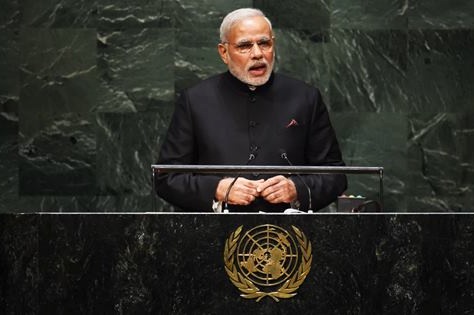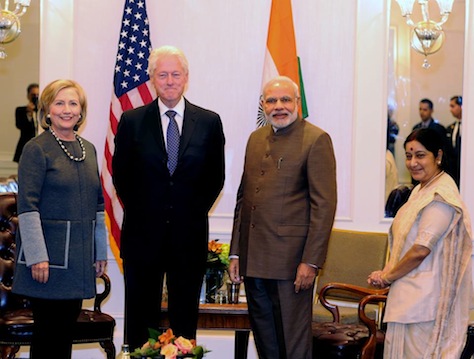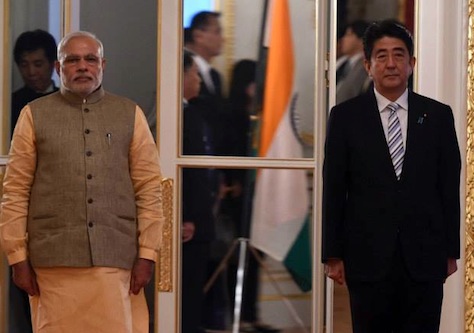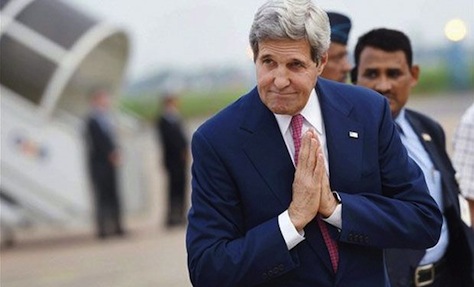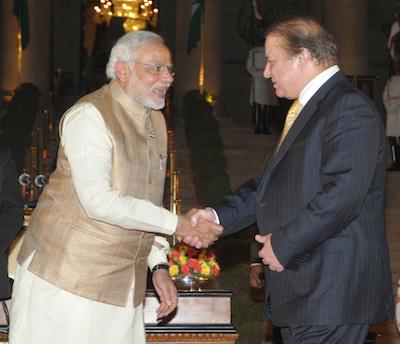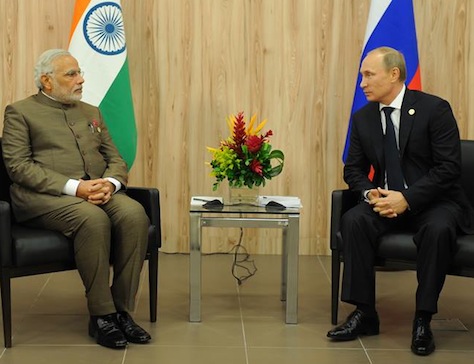Indian prime minister Narendra Modi took power less than five months ago, but he’s already made five major world visits, including to Japan, to the BRICS summit in Brazil and this week, Modi is sweeping through an action-packed five-day visit to the United States.![]()
His current visit to New York and Washington has the air of triumph about it, and his speech to nearly 19,000 fans at Madison Square Garden certainly marks one of the very few times that a foreign leader has drawn such genuine support from an American audience. It’s all the more amazing, given that for much of the last decade, the US government refused Modi a visa to travel to the United States, due to his questionable role in the 2002 Hindu-Muslim riots, which took place four months after Modi became the chief minister of Gujarat state.
India’s foreign relations with major world powers like the United States, Russia and China aren’t always easy, and its relationships with other south Asian neighbors, especially Pakistan, can often be downright frosty.
Nevertheless, there are at least two reasons why Modi has such a strong opportunity to maximize India’s role on the world stage today — and none of it has to do with India’s economy, which is growing far slower than it needs to sustain truly transformational gains.
The first is the world’s growing multipolarity, which must seem especially multipolar from New Delhi’s view. Neighboring China is poised to become the world’s largest economy within a decade. India also has longstanding ties with Russia dating to the Soviet era that are now especially relevant as Russian president Vladimir Putin reasserts his country’s might in its ‘near-abroad.’ That makes cooperation with India, the world’s second-most populous country, a strategic advantage for any major power, and it gives India considerable leverage.
The second is the nature of Modi’s election in May. With 336 seats in the Lok Sabha (लोक सभा), the lower house of the Indian parliament, Modi’s Bharatiya Janata Party (the BJP, भारतीय जनता पार्टी) has the strongest majority and boldest mandate than any Indian government since 1984. While no one knows whether Modi can use that strength to revitalize India’s public sector and institute reforms to boost its private sector, the magnitude of his victory forced the world to take notice. If, as Modi promises, he can introduce robust economic reforms, a more liberalized Indian economy could birth a lucrative market of over 1.25 billion consumers, especially if Modi can lift India’s poor into a middle-class standard of living.
When Modi appointed Sushma Swaraj (pictured above earlier today with Modi, former US president Bill Clinton and former US secretary of state Hillary Clinton), the former leader of the Lok Sabha, as India’s new external affairs minister, it was a gesture of respect for an ally of the BJP old-guard leaders, such as LK Advani, who have largely been pushed aside in the Modi era. But it should have also been a sign that Modi, known for his micromanaging style, would take a hands-on approach to foreign policy.
Given the emphasis that Modi placed on good governance and economic reform, it might be surprising that he’s spent so much time in his first five months on international relations. Modi has so far been cautious on economic policy — for example, his first budget in July featured far more continuity than rupture, disappointing some of his booster.
So what do five months of Modi’s foreign policy tell us about what we might expect over the next five years?
Plenty — especially on the basis of his international efforts as Gujarat’s 13-year chief minister.
Here’s a look at how Modi’s efforts in reaching out to five other global powers already provide strong hints to the Indian prime minister’s worldview, and how we might expect India to engage the rest of the world for the foreseeable future.
1. Japan
The fulcrum to Modi’s foreign policy might lie in Tokyo.![]()
Modi often turned to Japan as Gujarati chief minister as a source of investment, and that relationship explains why Modi’s first international visit outside south Asia was to Japan on August 30.
The ease with which Modi works with leaders like Japan’s prime minister Shinzō Abe (安倍 晋三) underlines Modi’s longstanding comfort with Japan.
As Shrey Verma wrote in Foreign Policy earlier this year, Modi turned to Japan out of necessity when Europe and the United States largely shunned him in the wake of the 2002 Gujarati riots, and that blossomed a mutually beneficial relationship over the years:
His visit to Japan in 2007 was an icebreaker of sorts, opening new investment channels between the Indian state and a foreign country. In the years since, Gujarat’s administrative efficiency and investor-friendly climate have rapidly attracted Japanese investments, with significant investment flowing into mega infrastructure projects. Suzuki, the Japanese auto giant, is already setting up new plants and ancillary units in the region, and private Japanese investment in Gujarat is expected to total $2 billion by 2015-2016. The investment spree is not restricted to Japanese multinationals. In 2009, the Japan External Trade Organisation (JETRO), a trade and investment agency under the Japanese government, partnered with Gujarat to organize the Vibrant Gujarat Global Investors Summit, a mini-Davos showcase event to attract foreign investment. Japan was designated “partner country” to the summit and represented by a senior delegation led by the Japanese ambassador.
As prime minister, Modi shows every indication of turning his strong economic partnership with Japan into a strategic and defensive one as well. Japan is a growing political (and perhaps, one day, military) counterweight to China within east Asia. To the extent India’s relationship with Japan is even stronger today under the Modi government, that places pressure on China to take special care not to alienate India.
After Australia, perhaps, the United States still considers Japan its chief ally in Asia on everything from security to economic matters, so Modi’s close relationship with Abe and other Japanese policymakers and industry leaders can serve as indirect conduits to US officials and businessmen.
2. United States
Though Modi is visiting the United States less than five months after he took office, his meeting tonight with US president Barack Obama comes after meeting the leaders of China, Japan, Brazil and Russia, though US secretary of state John Kerry (pictured above) visited Modi in late July.![]()
It’s not that Obama is an afterthought, but it’s clear that India’s foreign policy doesn’t begin and end with the United States. But US officials already face a handicap, on a personal level, due to Modi’s prohibition from US travel over the past decade. The issue still permeates US-Indian relations, and a federal court in New York three days ago issued a summons for Modi to respond to a suit that alleges Modi committed human rights abuses, despite Modi’s immunity as a head of government.
Relations reached a new apex in 2008, when president George W. Bush and former Indian prime minister Manmohan Singh concluded a nuclear deal that welcomed India into the global nuclear weapons club. In the Obama era, relations have stagnated. The economic trade promised by the Bush-era nuclear cooperation deal has not materialized, and diplomatic snafus on the part of the Obama administration, including the strip-search of an Indian diplomat in New York last year, needlessly soured the bilateral relationship even before Modi took office.
There’s a sense that the United States, too, has put India much lower on its priority list. It was embarrassing when US ambassador Nancy Powell resigned a week before India’s six-week election cycle began in April, but it’s perhaps even more embarrassing that Obama only named her permanent replacement two weeks ago. His choice, former State department official Richard Verma, may be a great diplomat, but he hardly has the stature of a long line of former US ambassadors to India, including economist John Kenneth Galbraith, future senator Daniel Patrick Moynihan and former congressman Tim Roemer.
But there are other, unofficial, ambassadors who may soothe US-Indian relations. The world-renowned, US-trained economist Arvind Subramanian, a former International Monetary Fund official, is widely tipped to become Modi’s chief economic adviser. Former University of Chicago professor and economist Raghuram Rajan currently serves as the Reserve Bank of India’s president.
Moreover, India will look to the United States for signs that it intends to balance China’s sometimes menacing rise in east Asia by supporting not only Japan, but the Philippines and even Vietnam, all of which have grown warier of Chinese muscle-flexing over the last 24 months.
3. China
When Modi gave an interview to CNN’s Fareed Zakaria earlier this month, he responded forcefully to whether India could become ‘the next China’:![]()
India does not need to become anything else. India must become only India. This is a country that once upon a time was called ‘the golden bird’. We have fallen from where we were before. But now we have the chance to rise again. If you see the details of the last five or ten centuries, you will see that India and China have grown at similar paces. Their contributions to global GDP have risen in parallel and fallen in parallel. Today’s era once again belongs to Asia. India and China are both growing rapidly together. That is why India needs to remain India.
Modi’s answer tells us less about India than his views about its relationship with China. That interview came just days after Chinese president Xi Jinping (习近平), himself less than two years in office, visited Modi in New Delhi on September 17.
Together, the two countries are home to over 36% of the world’s population and, as US officials have discovered, both Indian and Chinese cooperation is necessary on matters as disparate as Asia-Pacific security, nuclear non-proliferation and establishing global environmental standards. Nevertheless, China and India have often had a rocky history, including a longstanding dispute over the Himalayan border dividing the two countries.
Modi needs the kind of large-scale investment that only China can provide, and Xi needs Indian support to boost China’s position as the anchor of East Asian and Pacific stability. Modi has made it clear that there are limits to what he will accept. Even when Modi reached out to Japan, he did so with one eye on China, subtly chiding Chinese ‘expansionism’ when he visited Tokyo.
4. Pakistan and south Asia
When Modi extended an invitation to Pakistan’s prime minister, Nawaz Sharif, to attend his swearing-in ceremony in May, Sharif took him up on the offer. That was a surprise to many in both countries, in light of the Pakistani military’s continuing clout and its known antipathy for Sharif’s efforts to strengthen ties with India. ![]()
But Sharif’s grip on power has slipped in the meanwhile, and the military has been the main beneficiary of opposition protests led by Imran Khan and others who claim, somewhat improbably, that Pakistan’s 2013 elections were fraudulent.
Like his predecessors, Modi has made clear that Sharif’s overtures will mean nothing until and unless he can consolidate control over both his government’s military and intelligence services and, more importantly, Islamist radicals that Indian officials hold responsible for terrorist activity in India, including the 2008 Mumbai bombings.
Greater trade between the two countries, which were split in 1947 during Partition out of the greater British India into Hindu-majority and Muslim-majority states, should be at the top of their agenda.
No one expects Modi to bring the two nuclear-armed countries to the brink of war, like the previous BJP government in the late 1990s and early 2000s, but nor is anyone optimistic that Sharif has the domestic political strength to meet Modi’s demands that would precede truly normalized relations. The contested status of India’s Muslim-majority state, Jammu and Kashmir, shows no sign of abating, and it continually flares as a stressful point for both countries.
Modi’s first trip abroad was to neighboring Bhutan, where prime minister Tshering Tobgay won the Himalayan country’s second-ever election last summer, in part by emphasizing closer relations with India (over China). As US military forces leave Afghanistan, India will take a keen security interest in Kabul, where former World Bank official Ashraf Ghani was sworn in as president on Monday after a dubious and fraud-riddled election.
Compared to the rest of the world, south Asia lags behind with respect to trade liberalization — and that goes for the entire region, not just India and Pakistan. This is an area where Modi could easily boost Indian growth by reducing barriers to trade.
5. Russia
Throughout the Cold War, India was chiefly closer to the Soviet Union, while the United States was closer to Pakistan.![]()
Today, the links between Russia and India have less to do with socialist ideology and more to do with pecuniary interest. Both counties have an incentive to build a gas and/or oil pipeline between Russia and India, though Modi would naturally rather that it not run through Pakistan.
Russian president Vladimir Putin will follow Xi to New Delhi in December to hold bilateral talks with Modi, as part of an annual meeting between the two countries’ leaders. Modi and Putin, who both lead ‘BRIC’ countries, met in Fortaleza in July, when Modi referred to Russia as India’s ‘greatest friend.’
Beyond their traditional ties, both countries have a strong interest in building alternative financial institutions and networks outside of the United States and Europe.
6. The rest of the world
As chief minister of Gujarat, Modi routinely worked to attract investment to the Middle East — and historically, Gujarat, on the western Indian coast, always had longstanding ties to the Middle East for trade and commerce. The most successful of Modi’s endeavors came from wooing the United Arab Emirates, which became a perennial favorite at Modi’s biannual ‘Vibrant Gujarat’ conferences, and now is expected to become the hub of Indian-Arab relations. ![]()
Likewise, Modi cemented ties with Brazil, the remaining original BRIC country, at the BRICS summit held there in July when he met Brazilian president Dilma Rousseff for bilateral talks that resulted in agreements for greater cooperation in environmental policy, energy development and trade.![]()
Those deals may not amount to much, but it’s more than Modi has achieved with European leaders. En route to Brazil, Modi stopped in Berlin briefly to meet with German chancellor Angela Merkel, though she stood him up, ironically, to go to Brazil to watch Germany’s football team compete in the World Cup. ![]()
In the meanwhile, Modi hasn’t felt any pressing need to meet British prime minister David Cameron, French president François Hollande or Italian prime minister Matteo Renzi. Like the United States, the European Union made it clear that Modi, due to the 2002 Gujarati riots, wasn’t incredibly welcome in Europe over the last decade. That Europe is little more than an afterthought to Modi should be a wake-up call about its dwindling global economic and political resonance.
